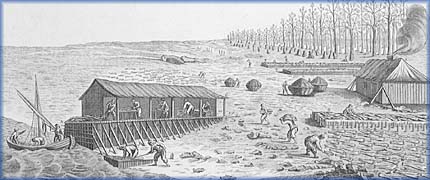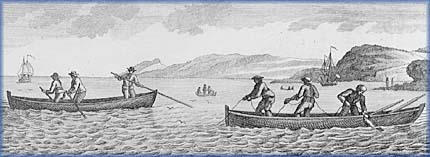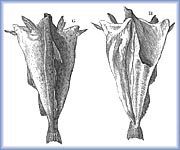|
The Dry Fishery
The dry fishery was carried out from shallops,
mainly along the shores of Newfoundland, Labrador, the Gaspé
Peninsula, Cape Breton and Chaleur Bay.
 t is also known as the
sedentary fishery because the crews from the ships, usually over
100 men, remained ashore from spring until fall. They set up what
they need on the beach, erected a wharf for unloading the fish and
built cabins to live in. The fresh cod was cleaned, salted, and
dried on the beach. In the fall, the dried cod was transported to
ports in southern France, Spain, Portugal and other Mediterranean
countries. t is also known as the
sedentary fishery because the crews from the ships, usually over
100 men, remained ashore from spring until fall. They set up what
they need on the beach, erected a wharf for unloading the fish and
built cabins to live in. The fresh cod was cleaned, salted, and
dried on the beach. In the fall, the dried cod was transported to
ports in southern France, Spain, Portugal and other Mediterranean
countries.
|

|
|
A station for the dry fishery, 18th century
The preparation and drying of the cod
Based on Traité général des pesches,
by Duhamel du Monceau, in Encyclopédie, fisheries plates
(Paris: Éditions Panckoucke, 1793)
(Collection of Nelson Cazeils, Biarritz, France)
|
|
After 1650, fishing proprietors in New France and the byboatkeepers
in Newfoundland, who lived year-round along the coast, also engaged
in this type of fishery.
|

|
|
The shallop fishery, 18th century
Based on Traité général des pesches,
by Duhamel du Monceau, in Encyclopédie, fisheries plates
(Paris: Éditions Panckoucke, 1793)
(Collection of Nelson Cazeils, Biarritz, France)
|

|

Dried cod, also known as flat cod
(how the English prepared the fish)
From Traité général des pesches,
by Duhamel du Monceau, 1772
(National Library of Canada)
|
|
|



